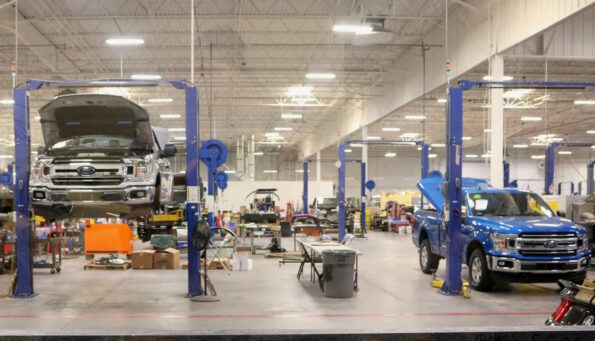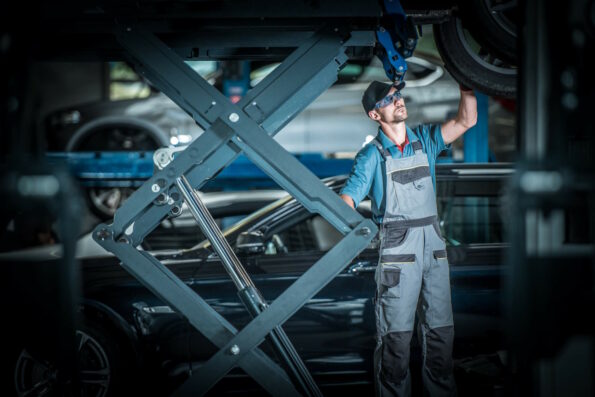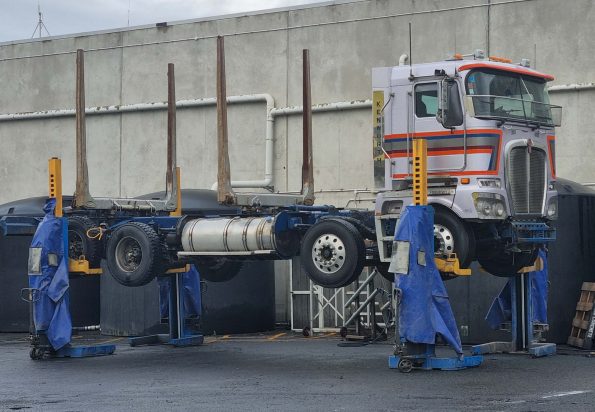Mechanics would struggle to fix many of the more common issues if it weren’t for the humble car lift or hoist. This post takes a look at these devices and uncovers a few different types that exist to help uncover the underside of your vehicle so that problems can be diagnosed and fixed quickly and safely.
Two-post lift

This lift is arguably the most common, and the one that you will most likely see at your local mechanic. As the name suggests, the two-post lift features two vertical columns supporting the vehicle, one on each side towards the front. A two-post lift will allow for more headroom in a garage because the lifting arms support the frame rather than the tyres; this can give as much as another 150mm of virtual height to the underside of the vehicle (i.e. the same amount as the ground clearance) vs a lift with ramps or runways. Many garages prefer to install these options because it tends to be easier to get equipment manufacturer lift parts when they need repairing, and they take up less room. A two-post lift must be anchored to the ground.
Four-post lift
A four-post lift allows for more flexibility in vehicle positioning because it has two ramps suspended between the four posts, which the vehicle is driven onto. They support much more weight than a 2-post lift, therefore are better for heavy vehicles such as SUVs and trucks. They are also better for vehicles with lower suspension such as sports cars and race cars. Four-post lifts can be on casters and be moved around the workshop.
If you are using your lift to store your car, e.g. like a car stacker, then a four-post lift is more convenient and better for the vehicle. With a 2-post lift, you have to ensure that the lifting apparatus is in the perfect place before lifting, whereas the 4-post lift’s ramps support the wheels.
A four-post lift requires an auxiliary lift to lift the vehicle off the ramps to allow for inspection and checking of all parts; not all do. Without an auxiliary lift, it’s not possible to check the wheels and suspension because they are supporting the weight of the vehicle. Some garages may have a 2-post lift and a 4-post lift to give them more flexibility.
The four-post configuration demands more space within a service bay compared to the two-post alternatives. Moreover, investing in and installing is often far costlier, making it less appealing to smaller operations.
Scissors

The scissor list stands out from traditional hydraulic lifts with its unique design. Rather than rising vertically, this lift provides movement through an interlocking arrangement of X-shaped frames. This allows for a far smaller footprint, making it beneficial for garages with limited space. Nevertheless, these lifts are unsuitable when high-clearance access is required due to the limited rise provided by scissor arms rather than hydraulic masts. They are relatively cheap to purchase. They must be anchored to the ground.
Parallelogram
With other lifts, the vehicle may shift angle as it rises but the parallelogram uses linked panels that form a rectangular framework to easily compensate for this issue. This constant-level capability allows technicians to roll under vehicles on creeper seats or tool carts, even at maximum elevation. It also helps maintain consistent brake pedal or gas pedal positioning for repairs that require partial actuation. The simple and stable lifting mechanism provides a smooth operation that is easy on both the vehicle and the lift itself. These types of lifts are commonly used for very heavy vehicles such as heavy trucks, buses and forklifts.
Mobile column lifts
The final type, which are also almost exclusively used for heavy vehicles, are mobile column lifts. These can either be moved with a forklift, or some have wheels like a pallet jack. Here we see a truck being suspended by four of them at our parent company, TR Group.

As you can see, there are far more lift varietals than you might have thought possible. Each option has its upsides and downsides, with garages and workshops making their choices based on personal needs, workshop layout and vehicle choice.
